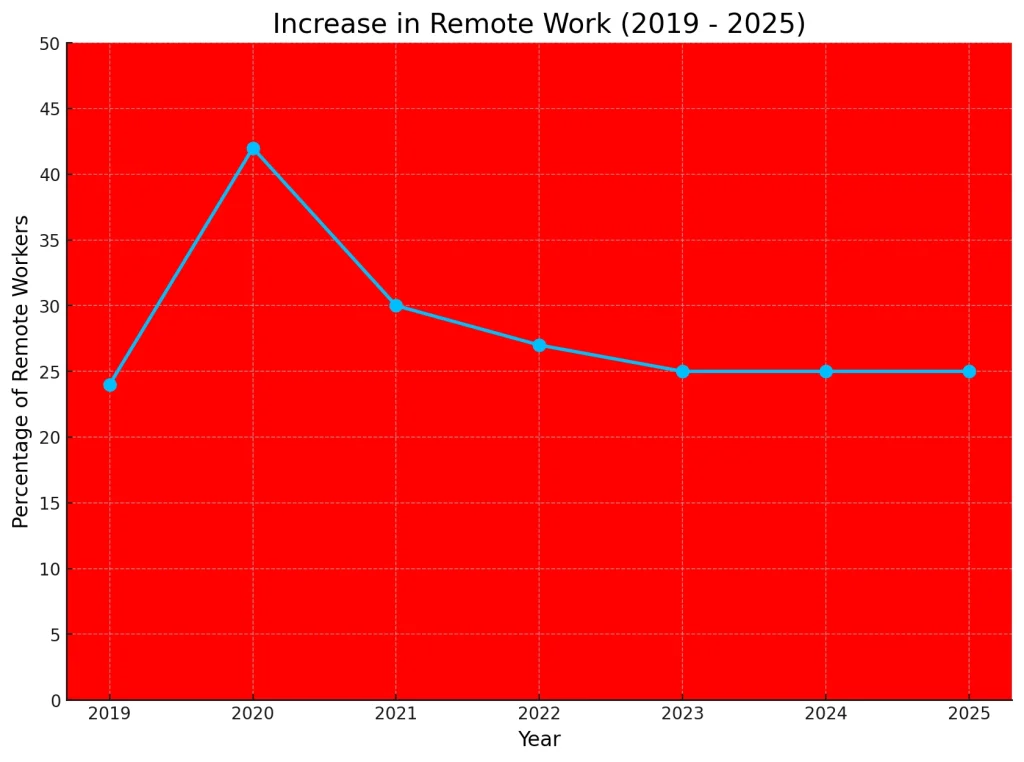Introduction
Remote job opportunities for SMB professionals are expanding rapidly, allowing skilled individuals to work flexibly with small and medium-sized businesses worldwide while contributing their expertise from anywhere. Remote work has transformed the professional landscape, especially for SMB professionals. In 2025, remote jobs are no longer limited to tech giants—they span marketing, customer service, sales, content creation, and more. Flexible work options allow businesses to tap into talent globally, while employees gain autonomy, work-life balance, and access to career growth opportunities.
This article explores top remote job opportunities for SMB professionals, highlighting required skills, industry trends, collaboration tools, and practical strategies to succeed. For a broader perspective on remote work trends, see our pillar post: The Future of Remote Work: Career Opportunities & Client Collaboration.
Benefits of Remote Work for Small and Medium-Sized Businesses
In recent years, remote work has transformed from a temporary solution into a long-term strategy for many small and medium-sized businesses (SMBs). This shift isn’t just about convenience—it’s about creating smarter, more efficient, and more competitive organizations.
1. Lower Operational Costs
Remote work reduces the need for expensive office space, utilities, and equipment. SMBs can save thousands each year on rent and maintenance, allowing them to reinvest those funds into growth areas like marketing, technology, or talent development.
2. Access to a Wider Talent Pool
By hiring remotely, small businesses are no longer limited to local talent. They can recruit skilled professionals from across the country—or even globally. This access helps SMBs find the right expertise at competitive rates, enhancing innovation and productivity.
3. Increased Employee Productivity and Satisfaction
Studies show that remote employees often experience fewer distractions and enjoy better work-life balance. When people work in their preferred environment, they tend to be more focused and loyal—leading to higher productivity and lower turnover rates.

4. Business Continuity and Flexibility
Remote setups make SMBs more resilient to unexpected challenges like natural disasters or market disruptions. Teams can stay connected and keep operations running smoothly, no matter where they are located.
5. Environmental and Social Impact
Fewer commutes mean a smaller carbon footprint and less traffic congestion. Remote work also supports inclusivity by offering opportunities to parents, people with disabilities, or those living in rural areas.
In short, remote work isn’t just a modern trend—it’s a strategic advantage for SMBs. By embracing flexible work models, small businesses can cut costs, boost performance, and attract world-class talent to thrive in a digital-first economy.
Common Challenges in Remote Work for Small and Medium-Sized Businesses
While remote work offers flexibility and cost savings, it also brings several challenges—especially for small and medium-sized businesses (SMBs) that are still adapting to digital operations. Understanding these obstacles is the first step toward building a more effective remote work strategy.
1. Communication Gaps
In a remote setup, employees often work across different locations and time zones. Without clear communication tools and processes, important messages can get lost, causing delays and misunderstandings. SMBs must invest in reliable collaboration platforms like Slack, Zoom, or Microsoft Teams to keep teams aligned.
2. Maintaining Team Collaboration and Culture
When employees don’t see each other daily, it becomes harder to build trust and team spirit. Remote teams can feel disconnected, which may affect creativity and morale. SMB leaders should schedule virtual team meetings, social check-ins, and recognition programs to keep everyone engaged.
3. Performance Tracking and Accountability
Without direct supervision, managers sometimes struggle to monitor productivity. This challenge can lead to either micromanagement or lack of oversight. The solution lies in setting clear goals, tracking progress through project management tools, and focusing on results rather than hours worked.
4. Cybersecurity Risks
Remote work increases exposure to online threats, especially when employees use personal devices or unsecured networks. SMBs need to enforce cybersecurity policies, provide training, and use VPNs or encrypted tools to safeguard business data.

5. Work-Life Balance Issues
Remote employees often find it hard to separate work from personal life, leading to burnout. Encouraging flexible schedules and regular breaks can help maintain healthy boundaries.
By recognizing these common challenges, SMBs can proactively create strong systems, digital policies, and support networks to ensure remote work success. With the right strategies, these obstacles can turn into opportunities for smarter, more connected teams.
Estimated Remote Work Growth Percentage (2019–2025)
-
2019 (Pre-Pandemic):
-
Remote work percentage: ~24% of U.S. employees worked remotely at least part-time (according to a 2019 report from the U.S. Bureau of Labor Statistics).
-
Global trend: Around 16% of the global workforce worked remotely.
-
-
2020 (Pandemic Impact):
-
Remote work percentage (U.S.): ~42% of the U.S. workforce worked remotely full-time during the pandemic lockdowns.
-
Global trend: Approximately 30% of the global workforce switched to remote work as businesses adapted to the pandemic.
-
-
2021 (Pandemic Recovery & Hybrid Models):
-
Remote work percentage (U.S.): ~30% of U.S. employees worked remotely full-time or in hybrid models.
-
Global trend: By 2021, 35% of the global workforce worked remotely, with many companies shifting to hybrid models.
-
-
2022 (Post-Pandemic Normalization):
-
Remote work percentage (U.S.): ~27% of the U.S. workforce remained fully remote. Hybrid work models became the norm for many businesses.
-
Global trend: 40% of global employees worked remotely in some capacity, with 30% working full-time remotely.
-

-
2023 (Ongoing Remote Work Growth):
-
Remote work percentage (U.S.): Approximately 25-30% of employees in the U.S. worked remotely full-time, while hybrid work continued to dominate.
-
Global trend: Remote work remained high at around 35-40% globally, with businesses across industries embracing flexible work arrangements.
-
-
2024 (Sustained Remote Work Adoption):
-
Remote work percentage (U.S.): ~25-30% of workers still remote, with many companies shifting toward permanent hybrid work models.
-
Global trend: Around 40% of the global workforce continued working remotely, driven by increased flexibility and the widespread adoption of remote tools.
-
-
2025 (Future Projection):
-
Remote work percentage (U.S.): Estimated to remain 25-30% of the workforce working remotely full-time, with an increased number of hybrid positions.
-
Global trend: The global remote workforce is expected to stabilize at 40-45%, with some companies expanding their remote work offerings.
-
The Rise of Remote Work
Remote work adoption has accelerated due to digital transformation, pandemic-era adjustments, and technological advancements. SMBs increasingly rely on remote teams for tasks including customer support, marketing campaigns, and product development.
Key drivers:
-
Cloud-based productivity tools.
-
Video conferencing and collaboration platforms.
-
Cost efficiency and access to a larger talent pool.
Stats:
-
Forbes reports over 60% of SMBs plan to maintain remote work options through 2025.
-
HubSpot notes a 20–30% productivity boost in remote teams when structured correctly.
Top Remote Job Roles for SMB Professionals
-
Digital Marketing Specialists: Handle social media, content creation, SEO, and PPC campaigns.
-
Customer Success & Support Agents: Manage inquiries, complaints, and retention strategies remotely.
-
Content Creators & Copywriters: Produce blogs, videos, and social media content from home.
-
Sales & Account Managers: Close deals and maintain client relationships online.
-
Data Analysts & Reporting Specialists: Monitor metrics and provide insights for SMB decision-making.
For remote teams using short-form video, see: Video Marketing Made Easy: From Short Videos to Customer Feedback in 2025.
Skills in Demand
Remote SMB roles require a mix of hard and soft skills:
-
Technical: SEO, data analysis, CRM management, coding, digital design.
-
Soft: Communication, time management, self-motivation, adaptability.
Example:
A content strategist producing video and written content remotely may need video editing skills, SEO knowledge, and collaboration proficiency.
Remote Collaboration Tools
Effective remote work depends on digital collaboration platforms:
-
Zoom / Microsoft Teams – Video meetings.
-
Slack / Discord – Team communication.
-
Trello / Asana – Project management.
-
Google Workspace / Notion – Document sharing and productivity.
Tip: Combine tools for seamless workflows and maintain team alignment.
Tips for Thriving in Remote SMB Roles
-
Establish a dedicated workspace.
-
Set a daily schedule for focus and breaks.
-
Communicate proactively with team members.
-
Track tasks and metrics for accountability.
-
Embrace learning opportunities to stay competitive.
HubSpot outlines best practices for remote employees to maintain productivity and engagement (HubSpot Remote Work Guide).
Remote Work Strategies for Small and Medium-Sized Businesses
The rise of remote work has changed how small and medium-sized businesses (SMBs) operate. Once seen as a luxury, remote work is now a competitive advantage—offering flexibility, access to global talent, and lower overhead costs. However, to make it successful, SMBs must adopt the right strategies to keep teams productive, connected, and secure.
1. Establish Clear Communication Channels
Smooth communication is the foundation of successful remote work. SMBs should standardize tools for messaging, meetings, and project tracking. Platforms like Slack, Zoom, and Asana make collaboration seamless. According to HubSpot, having defined communication norms—such as expected response times and meeting cadences—helps remote teams stay aligned and efficient.
2. Build a Strong Remote Culture
A sense of belonging is crucial for remote employees. Regular virtual check-ins, recognition programs, and online social activities can strengthen company culture. Leaders should focus on transparency and empathy to ensure employees feel valued. Forbes highlights that a positive remote culture improves engagement and retention—read more in their article on remote leadership practices.
3. Implement Clear Performance Metrics
Instead of monitoring hours, SMBs should measure output. Setting clear KPIs (Key Performance Indicators) for each role helps employees understand expectations. Using tools like Trello, ClickUp, or Monday.com allows managers to track project progress in real-time while maintaining accountability without micromanagement.

4. Prioritize Cybersecurity
Remote work increases exposure to data breaches and phishing attacks. SMBs should enforce two-factor authentication, encrypted communication, and secure VPNs. Regular employee training on cybersecurity awareness can significantly reduce risks. A proactive approach protects both company data and customer trust.
5. Support Work-Life Balance
Encouraging flexible schedules and setting boundaries helps employees avoid burnout. Remote work should enhance productivity, not blur personal limits. Promoting healthy habits—such as regular breaks and digital detox hours—keeps your team focused and energized.
Final Thoughts
Remote work isn’t just a temporary trend; it’s the future of business. By embracing digital tools, transparent communication, and a culture of trust, SMBs can thrive in this new era of flexibility. With the right strategies, small businesses can compete globally—building stronger teams and delivering better results than ever before.
Frequently Asked Questions (FAQs)
Q1: What industries offer the best remote jobs for SMB professionals?
A: Marketing, customer support, sales, content creation, IT, and analytics.
Q2: How do SMBs manage remote teams effectively?
A: Using project management tools, video conferencing, and clear communication policies.
Q3: Can remote work improve career growth?
A: Yes, employees gain global exposure, skill diversification, and flexible career opportunities.
Q4: What is essential for a successful remote employee?
A: Self-discipline, digital literacy, proactive communication, and collaboration skills.
7. Conclusion
Remote work offers unprecedented opportunities for SMB professionals in 2025. By understanding top job roles, required skills, and collaboration tools, both businesses and employees can maximize productivity and growth. Strategic use of remote roles also supports survey collection, video marketing, and reputation management, linking back to broader business goals.
Learn more about the future of remote work: The Future of Remote Work: Career Opportunities & Client Collaboration.
